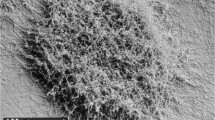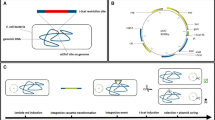Abstract
MEMBERS of the genus Streptomyces yield over 60% of known antibiotics1, including more than 70 commercial products2, as well as at least one very important enzyme (glucose isomerase). Members of the related genera Nocardia and Micromonospora produce some further valuable antibiotics (rifamycins, gentamicins). Recombination through conjugation is widespread in these actinomycetes3 but only to a very limited extent has it been applied to strain improvement. The main reason for its neglect has probably been the necessity to introduce selectable (for example drug resistance) or more generally counter-selectable (auxotrophic) markers into the strains to be crossed in order to identify recombinants occurring at frequencies of 10−6 or lower among predominantly asexual progeny. The marking of strains is time-consuming; moreover it may induce deleterious mutations along with the markers, and these will usually go undetected since auxotrophic mutations themselves often depress antibiotic yield. In certain cases, recombination occurs so rarely that single markers in each parent cannot be used to distinguish it from reverse mutation4, while in some strains no recombination has been detected3. The availability of a simple generally applicable procedure to recombine actinomycete strains at high frequency would therefore greatly facilitate the routine use of recombination in strain improvement. We report here such a procedure for Streptomyces which depends on polyethylene glycol (PEG)-induced protoplast fusion and regeneration. Recombination frequencies achieved by this technique are so high that selectable markers could be dispensed with, at least in certain kinds of strain improvement programmes.
This is a preview of subscription content, access via your institution
Access options
Subscribe to this journal
Receive 51 print issues and online access
$199.00 per year
only $3.90 per issue
Buy this article
- Purchase on Springer Link
- Instant access to full article PDF
Prices may be subject to local taxes which are calculated during checkout
Similar content being viewed by others
References
Bèrdy, J. Adv. appl. Microbiol. 8, 309–406 (1974).
Perlman, D. Am. Soc. Microbiol. News 43, 82–89 (1977).
Hopwood, D. A. & Merrick, M. J. Bact. Rev. (in the press).
Akagawa, H., Okanishi, M. & Umezawa, H. J. gen. Microbiol. 90, 336–346 (1975).
Okanishi, M., Suzuki, K. & Umezawa, H. J. gen. Microbiol. 80, 389–400 (1974).
Fodor, K. & Alföldi, L. Proc. natn. Acad. Sci. U.S.A. 73, 2147–2150 (1976).
Schaeffer, P., Cami, B. & Hotchkiss, R. D. Proc. natn. Acad. Sci. U.S.A. 73, 2151–2155 (1976).
Pontecorvo, G., Riddle, P. N. & Hales, A. Nature 265, 257–258 (1977).
Hopwood, D. A., Chater, K. F., Dowding, J. E. & Vivian, A. Bact. Rev. 37, 371–405 (1973).
Bibb, M. J., Freeman, R. F. & Hopwood, D. A. Molec. gen. Genet. (in the press).
Norwood, T. H., Zeigler, C. J. & Martin, G. M. Somatic Cell Genet. 2, 263–270 (1976).
Hales, A. Somatic Cell Genet. 3, 227–230 (1977).
Hopwood, D. A. Devl Ind. Microbiol. 18 (in the press).
Lomovskaya, N. D., Mkrtumian, N. M., Gostimskaya, N. L. & Danilenko, V. N. J. Virol. 9, 258–262 (1972).
Author information
Authors and Affiliations
Rights and permissions
About this article
Cite this article
HOPWOOD, D., WRIGHT, H., BIBB, M. et al. Genetic recombination through protoplast fusion in Streptomyces. Nature 268, 171–174 (1977). https://doi.org/10.1038/268171a0
Received:
Accepted:
Issue Date:
DOI: https://doi.org/10.1038/268171a0
This article is cited by
-
Improving the regeneration rate of deep lethal mutant protoplasts by fusion to promote efficient L-lysine fermentation
BMC Biotechnology (2023)
-
Protoplast preparation and reversion to the normal filamentous growth in antibiotic-producing uncommon actinomycetes
The Journal of Antibiotics (2010)
-
Protoplast Fusion and Gene Recombination in the Uncommon Actinomycete Planobispora rosea Producing GE2270
The Journal of Antibiotics (2007)
-
Properties ofSaccharopolyspora erythraea strains after protoplast regeneration
Folia Microbiologica (2005)
-
Genome shuffling leads to rapid phenotypic improvement in bacteria
Nature (2002)
Comments
By submitting a comment you agree to abide by our Terms and Community Guidelines. If you find something abusive or that does not comply with our terms or guidelines please flag it as inappropriate.



